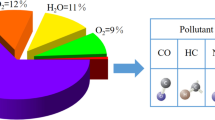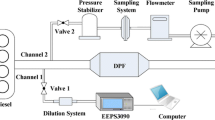Abstract
To study the effects of residual ash on the capture and regeneration of a diesel particulate filter (DPF), repeated capture and complete regeneration experiments were conducted. An engine exhaust particulate sizer was used to measure the particle size distribution of diesel in the front and back of DPF. Discrepancies in the size distribution of the particulate matter in repeated trapping tests were analyzed. To achieve complete DPF regeneration, a DPF regeneration system using nonthermal plasma technology was established. The regeneration carbon removal mass and peak temperatures of DPF internal measuring points were monitored to evaluate the effect of regeneration. The mechanism explaining the influence of residual ash on DPF capture and regeneration was thoroughly investigated. Results indicate that the DPF trapping efficiencies of the nuclear-mode particles and ultrafine particles have significant improvements with the increase quantity of residual ash, from 90 % and 96.01 % to 94.17 % and 97.27 %, respectively. The exhaust backpressure of the DPF rises from 9.41 kPa to 11.24 kPa. Heat transfer in the DPF is improved with ash, and the peak temperatures of the measuring points accordingly increase. By comparing the regeneration trials, the elapsed time for complete regeneration and time difference for reaching the peak temperature between adjacent reaction interfaces are extended with increased quantity of ash. The carbon removal mass rises by 34.00 %.
Similar content being viewed by others
References
Beatrice, C., Iorio, S. D., Guido, C. and Napolitano, P. (2012). Detailed characterization of particulate emissions of an automotive catalyzed DPF using actual regeneration strategies. Experimental Thermal and Fluid Science 39, 5, 45–53.
Burtscher, H. (2005). Physical characterization of particulate emissions from diesel engines: A review. J. Aerosol Science 36, 7, 896–932.
Chen, P. and Wang, J. (2014). Air-fraction modeling during active DPF regenerations. Applied Energy, 122, 310–320.
Chen, T., Wu, Z., Gong, J. and E, J. Q. (2016). Numerical simulation of diesel particulate filter regeneration considering ash deposit. Flow, Turbulence and Combustion 97, 3, 849–864.
Daggolu, P. R., Gogia, D. K. and Siddiquie, T. A. (2017). Exhaust after treatment system for diesel locomotive engines–A review. Locomotives and Rail Road Transportation, 2017, 155–168.
Fang, J., Meng, Z., Li, J., Pu, Y., Du, Y. and Li, J. (2017). The influence of ash on soot deposition and regeneration processes in diesel particular filter. Applied Thermal Engineering, 124, 633–640.
Fino, D. and Specchia, V. (2008). Open issues in oxidative catalysis for diesel particulate abatement. Powder Technology 180, 1–2, 64–73.
Gu, L., Cai, Y., Shi, Y., Wang, J., Xiaoyu, P., Xu, H. and Cui, Y. (2017). Experimental study on purification of diesel particulate matter by non-thermal plasma technology. Plasma Chemistry and Plasma Processing 37, 4, 1193–1209.
Ishizawa, T., Yamane, H., Satoh, H., Sekiguchi, K., Arai, M. and Yoshimoto, N. (2010). Investigation into ash loading and its relationship to DPF regeneration method. SAE Int. J. Commercial Vehicles 2, 2, 164–175.
Jang, J., Lee, Y. and Kwon, O. (2017). Comparison of fuel efficiency and exhaust emissions between the aged and new DPF systems of Euro 5 diesel passenger car. Int. J. Automotive Technology 18, 5, 751–758.
Kang, J., Chu, S., Lee, J., Kim, G. and Min, K. (2018). Effect of operating parameters on diesel/propane dual fuel premixed compression ignition in a diesel engine. Int. J. Automotive Technology 19, 1, 27–35.
Khan, M. Y., Johnson, K. C., Durbin, T. D., Jung, H., Iii, D. R. C. and Bishnu, D. (2012). Characterization of PMPEMS for in-use measurements conducted during validation testing for the PM-PEMS measurement allowance program. Atmospheric Environment 55, 3, 311–318.
Kuwahara, T., Nakaguchi, H., Kuroki, T. and Okubo, M. (2016). Continuous reduction of cyclic adsorbed and desorbed NOx in diesel emission using nonthermal plasma. J. Hazardous Materials, 308, 216–224.
Kuwahara, T., Nishii, S., Kuroki, T. and Okubo, M. (2013). Complete regeneration characteristics of diesel particulate filter using ozone injection. Applied Energy, 111, 652–656.
Lee, S. and Kim, T. Y. (2017). Performance and emission characteristics of a DIdiesel engine operated with diesel/ DEE blended fuel. Applied Thermal Engineering, 121, 454–461.
Liati, A., Eggenschwiler, D., Gubler, M., Schreiber, D. and Aguirre, M. (2012). Investigation of diesel ash particulate matter: A scanning electron microscope and transmission electron microscope study. Atmospheric Environment, 49, 391–402.
Littera, D. (2014). Investigation of PMFormation and Evolution in Plumes Emitted by Heavy-duty Diesel Vehicles: Wind Tunnel Study. M. S. Thesis. West Virginia University. Morgantown, West Virginia, USA.
Manni, M., Pedicillo, A. and Bazzano, F. (2006). A study of lubricating oil impact on diesel particulate filters by means of accelerated engine tests. Powertrain & Fluid Systems Conf. and Exhibition, 2006, 1, 3416.
Mokhri, M. A., Abdullah, N. R., Abdullah, S. A., Kasalong, S. and Mamat, R. (2012). Soot filtration recent simulation analysis in diesel particulate filter (DPF). Procedia Engineering, 41, 1750–1755.
Nour, M., Kosaka, H., Abdel-Rahman, A. K. and Bady, M. (2016). Effect of water injection into exhaust manifold on diesel engine combustion and emissions. Energy Procedia, 100, 178–187.
Okubo, M., Kuwahara, T., Yoshida, K., Kannaka, Y. and Kuroki, T. (2010). Improvement of NOx reduction efficiency in diesel emission using nonthermal plasmaexhaust gas recirculation combined aftertreatment. Industry Applications Society Annual Meeting, Houston, Texas, USA.
Palma, V., Ciambelli, P., Meloni, E. and Sin, A. (2015). Catalytic DPF microwave assisted active regeneration. Fuel, 140, 50–61.
Pu, X., Cai, Y., Shi, Y., Wang, J., Gu, L., Tian, J. and Li, W. (2017). Diesel particulate filter (DPF) regeneration using non-thermal plasma induced by dielectric barrier discharge. J. Energy Institute 6, 4, 1–13.
Sappok, A. and Wong, V. W. (2009). Lubricant-derived ash properties and their Effects on diesel particulate filter pressure drop performance. ASME Internal Combustion Engine Division Fall Technical Conf., Lucerne, Switzerland, 327–343.
Senda, J. and Kitamura, T. (2013). Diesel combustion: PM formation mechanism. Open J. Microphysics 3, 2162–2450, 43–46.
Shi, Y., Cai, Y., Li, X., Xu, H., Li, W. and Pu, X. (2016). Low temperature diesel particulate filter regeneration by atmospheric air non-thermal plasma injection system. Plasma Chemistry and Plasma Processing 36, 3, 783–797.
Squaiella, L. L. F., Martins, C. A. and Lacava, P. T. (2013). Strategies for emission control in diesel engine to meet euro VI. Fuel, 104, 183–193.
Tan, Y. H., Abdullah, M. O., Nolasco-Hipolito, C., Zauzi, N. S. A. and Abdullah, G. W. (2017). Engine performance and emissions characteristics of a diesel engine fueled with diesel-biodiesel-bioethanol emulsions. Energy Conversion and Management, 132, 54–64.
Wang, X., Cheung, C. S., Di, Y. and Huang, Z. (2012). Diesel engine gaseous and particle emissions fueled with diesel–oxygenate blends. Fuel, 94, 317–323.
Xu, B. Y., Liu, X. L., Jiang, L. L. and Xu, J. (2017). Simulation of mixed gas formation for a spray-wall complex guided LPG direct injection engine. Int. J. Automotive Technology 18, 3, 489–497.
Yamamoto, K., Oohori, S., Yamashita, H. and Daido, S. (2009). Simulation on soot deposition and combustion in diesel particulate filter. Proc. Combustion Institute 32, 2, 1965–1972.
Yoshida, K., Kuroki, T. and Okubo, M. (2009). Diesel emission control system using combined process of nonthermal plasma and exhaust gas components recirculation. Thin Solid Films 518, 3, 987–992.
Yu, H., Liang, X. and Shu, G. (2017). Numerical study of the early injection parameters on wall wetting characteristics of an HCCI diesel engine using early injection strategy. Int. J. Automotive Technology 18, 5, 759–768.
Zhao, H. and Wang, W. (2010). After-treatment Technology for Vehicle Diesel. 1st edn. Science and Technology of China Press. Beijing, China.
Zheng, X., Wu, Y., Zhang, S., Baldauf, R. W., Zhang, K. M. and Hu, J. (2016). Joint measurements of black carbon and particle mass for heavy-duty diesel vehicles using a portable emission measurement system. Atmospheric Environment, 141, 435–442.
Author information
Authors and Affiliations
Corresponding author
Rights and permissions
About this article
Cite this article
Cui, Y., Cai, Y., Fan, R. et al. Effects of Residual Ash on Dpf Capture and Regeneration. Int.J Automot. Technol. 19, 759–769 (2018). https://doi.org/10.1007/s12239-018-0073-5
Received:
Revised:
Accepted:
Published:
Issue Date:
DOI: https://doi.org/10.1007/s12239-018-0073-5




